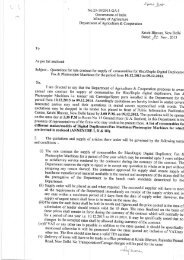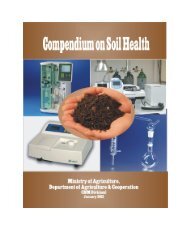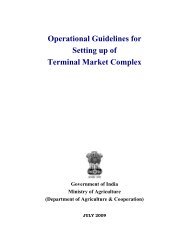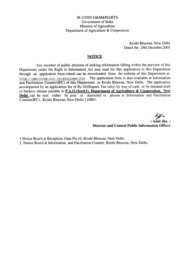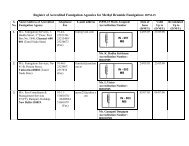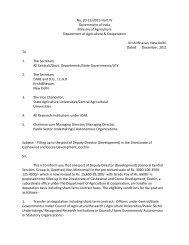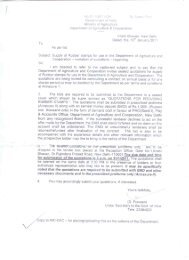Annual Report 2009-2010 - Department of Agriculture & Co-operation
Annual Report 2009-2010 - Department of Agriculture & Co-operation
Annual Report 2009-2010 - Department of Agriculture & Co-operation
Create successful ePaper yourself
Turn your PDF publications into a flip-book with our unique Google optimized e-Paper software.
<strong>Annual</strong> <strong>Report</strong> <strong>2009</strong>-<strong>2010</strong><br />
58<br />
10<br />
Agricultural Marketing<br />
10.1 Organised marketing <strong>of</strong> agricultural<br />
commodities has been promoted in the country<br />
through a network <strong>of</strong> regulated markets. Most <strong>of</strong><br />
the state governments and UTs have enacted<br />
legislation (the APMC Act) to provide for regulation<br />
<strong>of</strong> agricultural produce markets. While by the end<br />
<strong>of</strong> 1950, there were 286 regulated markets in the<br />
country, the number stands at 7,139 as on 31<br />
March <strong>2009</strong>. Besides, the country has 20,868 rural<br />
periodical markets, about 15 per cent <strong>of</strong> which<br />
function under the ambit <strong>of</strong> regulation. The advent<br />
<strong>of</strong> regulated markets has helped in mitigating the<br />
market handicap <strong>of</strong> producers and sellers at the<br />
wholesale assembling level. But, rural periodic<br />
markets in general and tribal markets in particular,<br />
remained out <strong>of</strong> the developmental ambit <strong>of</strong><br />
regulated markets.<br />
10.2 <strong>Co</strong>nstraints in the Present System <strong>of</strong><br />
<strong>Agriculture</strong> Marketing in India: The purpose <strong>of</strong><br />
state regulation <strong>of</strong> agricultural markets was to<br />
protect farmers from exploitation by intermediaries<br />
and traders and also to ensure better<br />
prices and timely payment for their produce. Over<br />
a period <strong>of</strong> time these markets have, however,<br />
acquired the status <strong>of</strong> restrictive and monopolistic<br />
markets, providing no help in direct and free<br />
marketing, organised retailing or smooth raw<br />
material supplies to agro-processing. Exporters,<br />
processors, and retail chain operators cannot<br />
procure directly from the farmers as the produce<br />
is required to be channelled through regulated<br />
markets and licensed traders. In the process, there<br />
is an enormous increase in the cost <strong>of</strong> marketing<br />
and the farmer ends up getting a low price for<br />
his/her produce. Monopolistic practices and<br />
modalities <strong>of</strong> state-controlled markets have<br />
prevented private investment in the sector. Postharvest<br />
losses are estimated to be <strong>of</strong> the order <strong>of</strong><br />
five to seven per cent in food grains and 25 to 30<br />
per cent in the case <strong>of</strong> fruits and vegetables.<br />
10.3 The Government has been playing an<br />
important role in developing the agricultural<br />
marketing system in the country. The <strong>Department</strong><br />
<strong>of</strong> <strong>Agriculture</strong> and <strong>Co</strong><strong>operation</strong> has three



